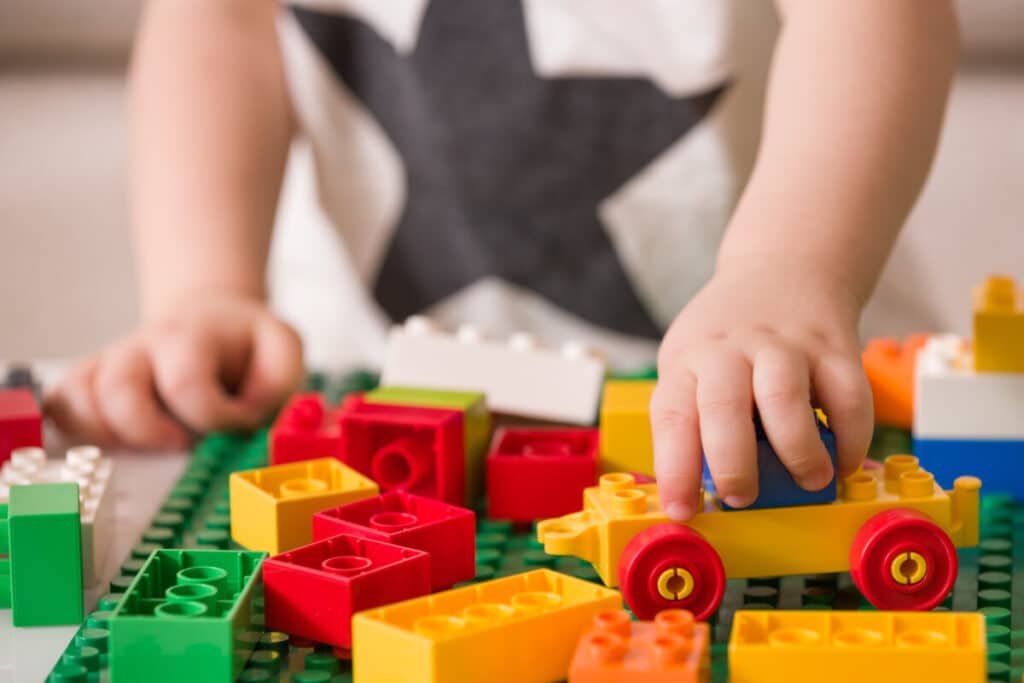Can Montessori Toys Be Plastic?
The Montessori method is popular, great for a wide variety of families, and something that parents can implement without too much supervision. Getting appropriate toys is one of the easiest parts of the Montessori process.
Most Montessori toys are made of natural materials like wood, metal, or wool, but there are some plastic Montessori-style toys that are more affordable for many families. Indoor slides, foam blocks, baby dolls, and toy tools are some plastic-based examples.
If you and your family are looking into the Montessori method, you’ll find many resources to set up the right toys for your child’s playroom. Keep reading below for more information on getting Montessori-style toys a little more affordably!

Can Montessori Toys Be Plastic?
Montessori toys are typically made of natural materials, but they can sometimes be made of plastic. Montessori experts would consider these exceptional circumstances, but functionality and accessibility for the child are some of the key components that have made the Montessori Method so popular around the world. For some families, that means using some plastic toys.
Why Are Natural Materials Prefered?
Natural materials are preferred for Montessori toys because they’re part of the overall experience for the child. Wood, metal, and wool all offer some weight and natural sensations that can’t be matched by synthetic or plastic materials. A child can teeth on wooden blocks and rings in a way that isn’t possible with plastic, and the rough feeling is supposed to be grounding.
Why is the Preference for Natural Materials Criticised?
As nice as the preference for all-natural materials is in theory, it becomes challenging in function. Many families who would benefit from the Montessori method end up spending too much money trying to match Social Media parenting standards, which is not in alignment with the core standards of Montessori. The child is driving their own learning and experiences, so priority should be on the child, not the ideal aesthetic.
Simple floor mattresses, walls without excessive decoration, and simple, functional toys are something that should be accessible to every parent. If the toys can be made of natural materials, that is awesome! If not, it won’t ruin the method or damage the child to use a plastic Montessori-style toy instead of a wooden one.
What is the Argument Over Plastic Montessori Toys?
Many people believe that Montessori toys must be made of natural materials like wood, wool, or metal and that anything falling outside of these parameters cannot be included in the Montessori circle. Why does it matter so much to some people?
The Expense of Wooden and Natural Toys
While the idea of natural toys is nice in theory, and there are a lot of great aspects involved in wooden toys, this standard is not realistic for all families. They are just too expensive.
Yes, wooden toys are sustainable, better for the environment, durable, and look darling displayed in a nursery, but they are often expensive and hard to find in stores and thrift shops. Insisting on wooden toys at the cost of excluding families from this method entirely can come off as a little pretentious. If a family has access to donated Montessori toys made of wood, they should be invited to use them! If all they can find and afford are plastic versions, those work fine.
The Environmental Impact of Plastic
Montessori people and environmentally conscious people tend to run in the same circles. Because of this, many of the concerns with plastic toys involve sustainability. This is fair, but advocates of wood should remember that it is fairly easy to find plastic Montessori-style toys like baby dolls and shape-insertion cubes in the aisles of secondhand shops and thrift stores.
Reusing and upcycling plastic items is environmentally conscious, which appeals to many parents and members of the Montessori community. Children don’t care if their toys came from the secondhand store, particularly when they’re toddlers, and parents can sanitize all toys thoroughly before bringing them into the playroom.
Health Risks of Plastic Toys
A smaller group of parents are concerned about the environmental impact of plastic toys around their children, especially when their children are at the teething stage. This concern will vary from person to person, but most children will be fine with some exposure to plastics as long as the parents stay aware of old and especially cheap toys that could contain lead. After all, the child shouldn’t be using their baby doll as a lunch plate. There are some limits to creativity.
What Are Some Examples of Good Plastic Montessori-Style Toys?
Some wonderful Montessori toys are much easier to find in plastic than in natural materials, and some make more sense when made of plastic. Some examples of this include:
- Baby dolls, especially anatomically correct baby dolls
- Indoor playground equipment like slides
- Legos and other building bricks used for unguided play
- Toys that encourage placing a shape in the corresponding hole
- Stacking rings for toddlers and babies
- Sensory toys
- Simple ball-tracker toys
Remember, the goal of Montessori toys is to entice the child to experiment and learn. Many wooden toys do not fulfill this purpose and are not inherently Montessori toys! A bin of plastic legos is more Montessori-appropriate than a bunch of random wooden toys could ever hope to be.
Just remember to keep it age-appropriate. After all, a young toddler’s idea of a lego experiment is taste-testing, and that isn’t going to get the results you want.
Should a Montessori School Use Plastic Toys?
Many parents would be shocked to find a Montessori school using plastic toys, but should they have that reaction?
Really, a reasonable number of plastic Montessori toys at a school or daycare is not a problem. A bigger concern would be the school advertising the Montessori method and not having the appropriate types of toys and experiences available to students. If all the toys are in the middle of the floor or locked in cabinets, teachers are supervising and directing every activity, or all playtime is structured, it doesn’t matter what the toys are made of.
Wooden toys are wonderful, but plastic toys help make Montessori accessible to areas that can’t always afford it. If it really bothers you, get some wooden toys donated and see what the school would like to implement. You might be able to make a positive change.

